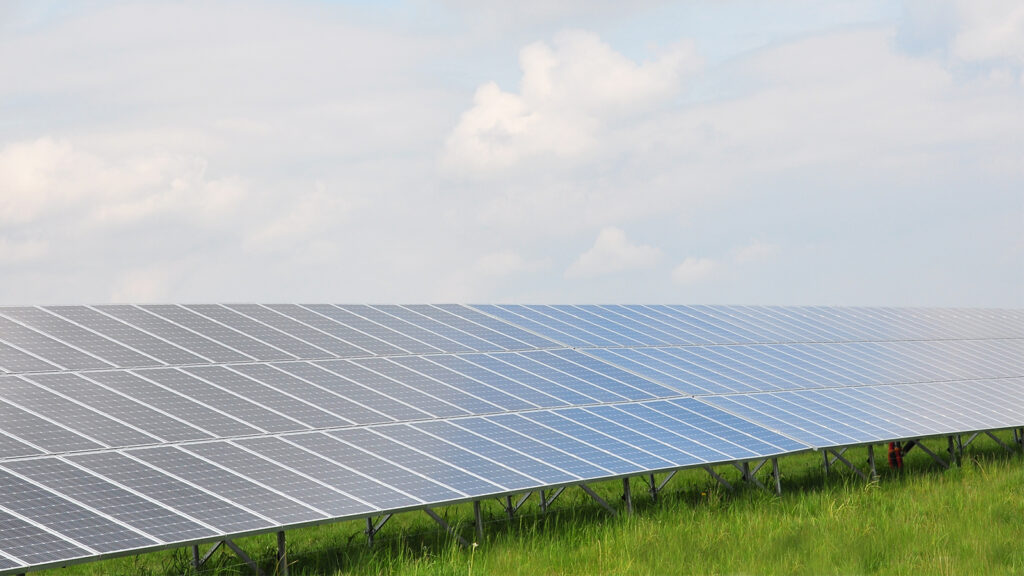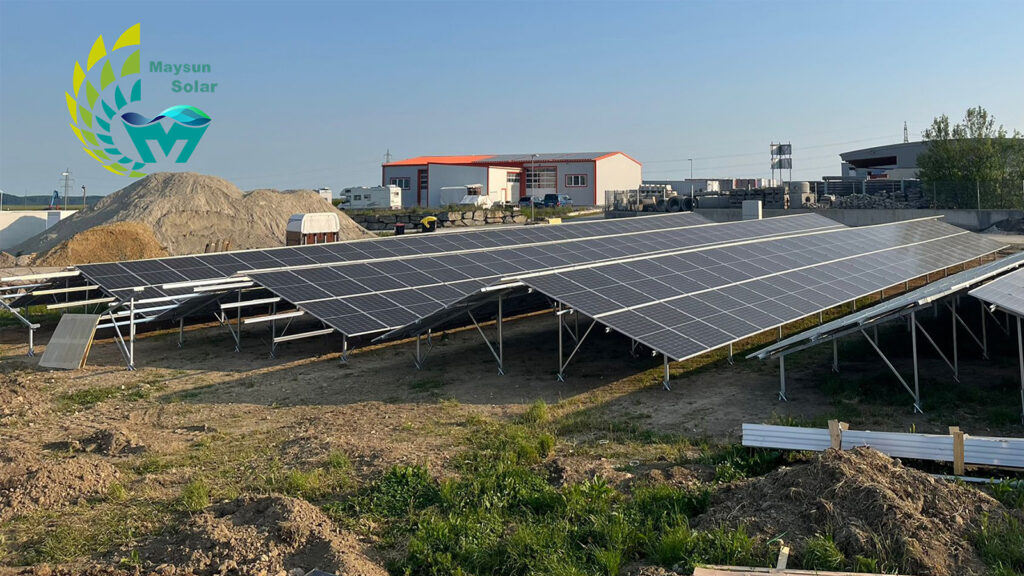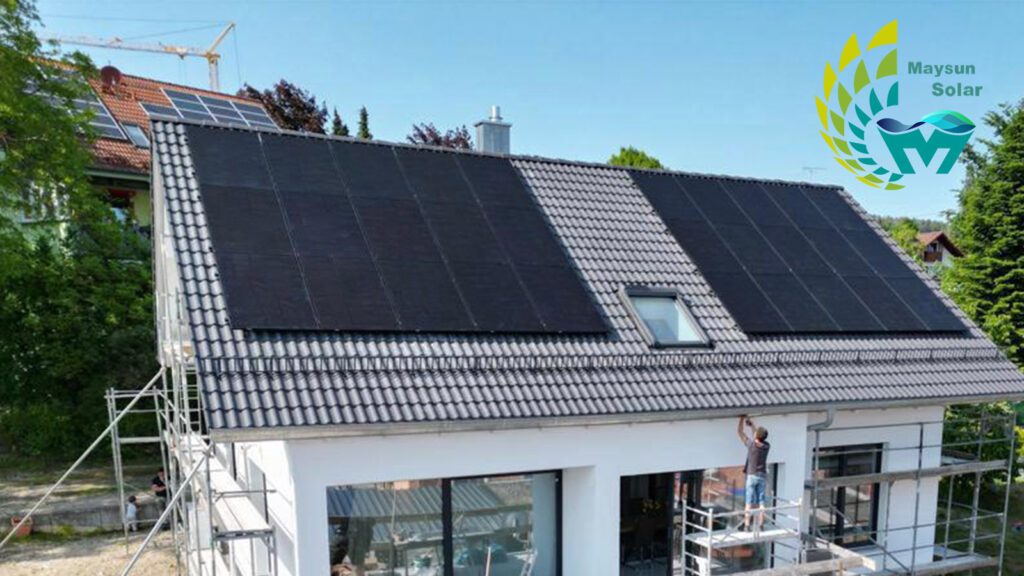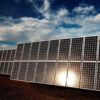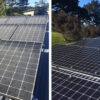Solar energy is becoming increasingly important as the demand for renewable energy grows. It is a solution that helps generate clean electricity. In the solar industry, manufacturers are always working to make solar panels better and more efficient. Two advanced technologies, IBC (Fork Finger Back Contact) and TOPCon (Thin Surface Passivation Contact), have gained significant attention in this field. In this blog post, we will discuss the differences between IBC and TOPCon solar panel technologies. We will explore the advantages of each and how they could shape the future of solar energy.
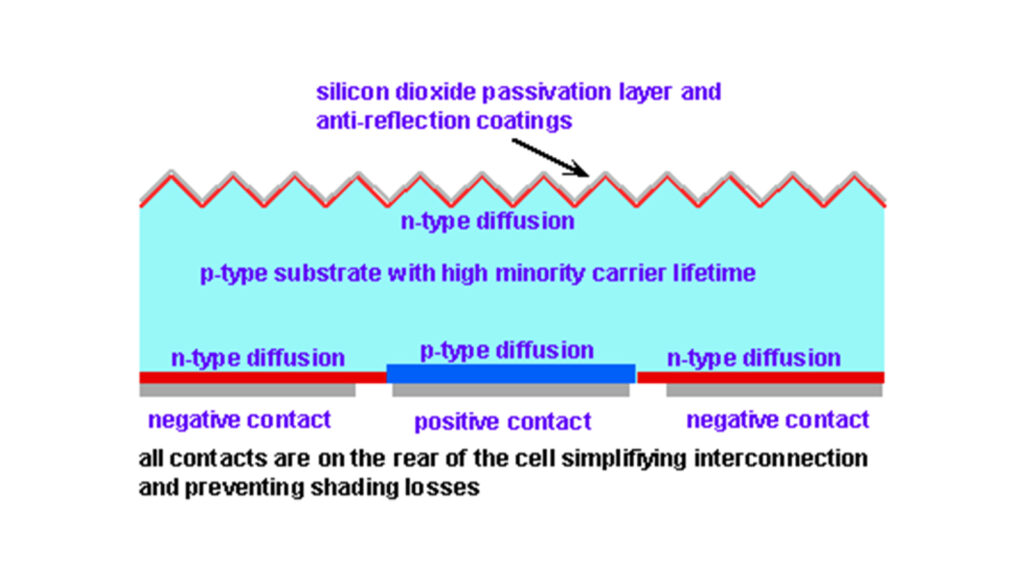
What is IBC Solar Panel Technology?
IBC (Interdigitated Back Contact) technology is a big step forward in the design of solar panels. The solar cell has a special design where the front and back contacts are placed on the back of the cell. This helps to make the front of the cell better at absorbing light, making it more efficient. This setup helps to minimize shading losses and therefore improves energy capture.
What are the advantages of solar panels with IBC technology?
- Improved efficiency: IBC cells increase the overall energy conversion rate by more than 20% by moving all the contacts to the back and increasing the effective area of the solar panel. This helps minimize shading losses.
- Improved aesthetics: IBC panels have a sleek and attractive design with no visible metal contacts or grid lines on the front. This makes them visually appealing for both residential and commercial installations. In some European countries, black solar panels are quite popular in residential areas. These panels are more expensive than traditional PERC panels because they complement dark-colored roofs and enhance the overall appearance.
- Better high-temperature performance: IBC technology has been found to perform better in high-temperature conditions compared to other technologies. Additionally, solar panels using IBC technology operate at lower temperatures than traditional panels. This makes them a better choice for areas with hot climates.
- Higher Durability: Placing the contacts on the backside offers more protection against things like moisture and dust. This helps prevent any damage that could happen over time and keeps the performance from getting worse.
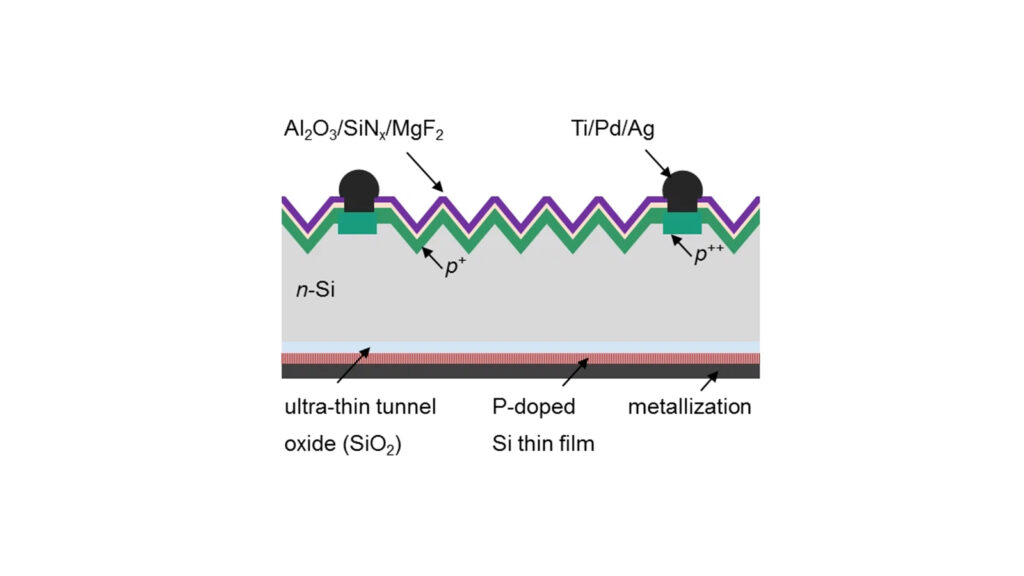
What is TOPCon solar panel technology?
Tunnel Oxide Passivated Contact (TOPCon) technology is a new method that helps enhance the efficiency of solar panels. TOPCon technology is essentially the next generation of PERC. TOPCon solar cells are built upon the passivated emitter and back-side cell (PERC) technology that already exists. Similar to its predecessor, TOPCon cells can be incorporated into cells that are manufactured using the conventional method. TOPCon is a technology that involves adding a very thin layer of silicon dioxide (SiO2) and a layer of phosphorus-doped polycrystalline silicon. This is done to create passivated contact structures on both the front and back surfaces. The TOPCon technology involves adding a very thin layer of silicon dioxide (SiO2) and a layer of phosphorus-doped polysilicon. This helps to reduce losses and improve the extraction of carriers by using passivated contact structures on both the front and back surfaces.
What are the advantages of TOPCon technology solar panels?
- Higher efficiency: TOPCon solar panels can achieve higher conversion efficiencies compared to conventional PERC technology. This is because they efficiently extract charge from the front surface and reduce compounding. Fraunhofer ISE states that TOPCon cells have the potential to achieve efficiencies of more than 25%, while PERC cells have a maximum theoretical efficiency of around 24%.
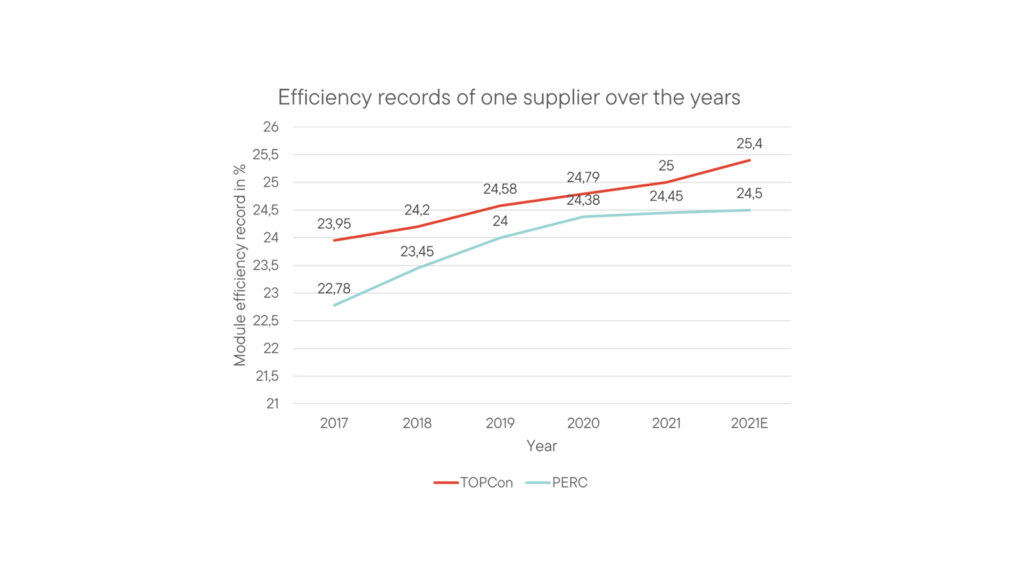
- Outstanding light absorption: TOPCon panels do not have frontal metal contacts, which actually helps them absorb more light and generate more power. TOPCon solar panels have a better ability to generate power in low light conditions. This means they can continue generating power for a longer period of time.
- Potential Cost Savings: TOPCon solar panels are made using a complex manufacturing process. However, the good news is that they can be made using the same machinery as P-modules. This means that manufacturers don’t need to spend a lot of money on new equipment. Additionally, TOPCon cells have better conversion efficiency, which means they can potentially lower the cost of manufacturing per watt.
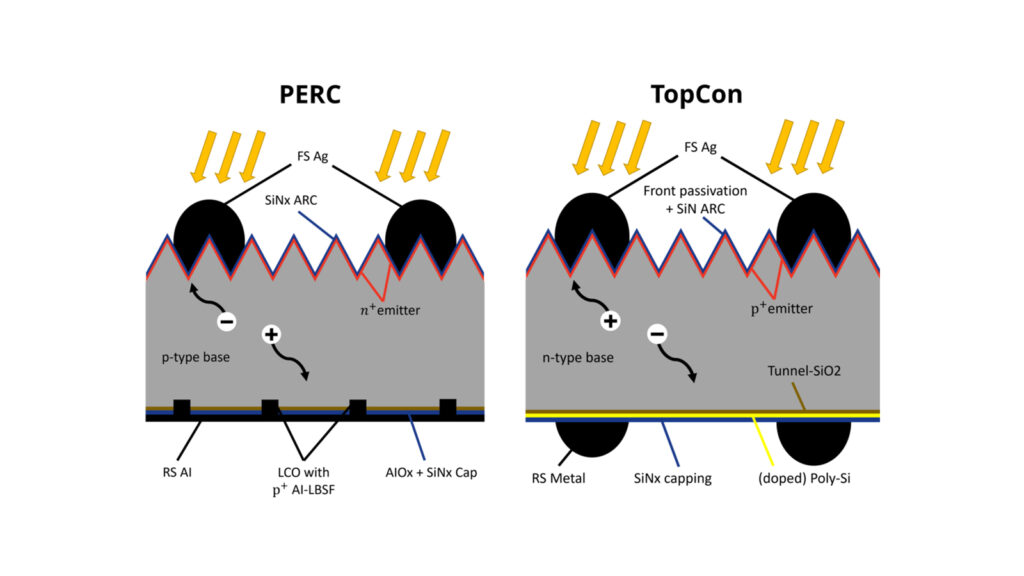
- Enhanced Reliability: TOPCon technology helps to decrease surface recombination and enhances the durability and consistent performance of the panels over time. The TOPCon solar panels have a low power degradation rate in the first year of operation and for the next 30 years.
What is the difference between IBC technology and TOPCon technology?
Both IBC and TOPCon technologies are important advancements in the solar industry. They are specifically developed to improve efficiency and performance. However, each of them has its own distinct features and things to consider.
- Generation Efficiency: Both technologies are highly efficient, with IBC panels being slightly more efficient in certain cases. Data shows that IBC has a theoretical conversion efficiency limit of 29.1%, which is higher than TOPCon’s 28.7%. However, the difference in efficiency between the two options is not significant.
- Manufacturing complexity: Although both technologies involve complex manufacturing processes, TOPContechnology may offer potential cost savings in the long run. Since TOPContechnology is the next logical step after PERC technology, it does not add much extra cost to the finished product, and it can produce additional efficiency gains over PERC.
- Commercial viability: Right now, whether these technologies can make money depends on a few things like how much they cost to make, if they can be produced on a larger scale, and if people actually want to buy them. IBC technology is advantageous because it can be combined with other cell technologies like TOPCon, HJT, Calcium Titanium Ore, etc. This combination results in higher conversion efficiencies and creates TBC, HBC, and PSC IBC technologies. Due to its versatility, IBC technology is often referred to as a “platform technology” that offers superior performance.
What is the future of IBC technology and TOPCon technology for solar panels?
To put it simply, both IBC and TOPCon solar cell technologies could greatly change the solar panel industry. They have the ability to improve efficiency and make solar energy more widely available and sustainable. IBC panels are known for their superior performance and commercial viability in high temperatures. On the other hand, TOPCon panels have higher efficiencies and potential cost savings. As solar technology keeps improving, it’s crucial to keep an eye on how both commercial use and technological advancements will shape the future of solar power.
Mayun Solar, a pioneer in renewable energy, has launched its latest breakthrough product, TOPCON full black double glass 410W-430W solar panel, which are cleverly designed to produce conversion efficiencies of up to 22%, making them ideal for use on residential rooftops and in large commercial enterprises!
Maysun Solar has set up offices, warehouses, and strong partnerships with skilled installers in numerous countries. If you have any questions about the latest module quotes or any PV-related inquiries, please don’t hesitate to contact us.

New Photovoltaic news you should know about (March 2024)
Table of Contents REC Unveils a 430 W Heterojunction Solar Module Boasting 22.2% Efficiency REC, a Singapore-based PV module manufacturer, introduces its residential solar modules featuring Alpha heterojunction cell technology. Production has commenced at REC’s Industry 4.0 fab in Singapore, with initial shipments

IBC Solar Modules vs. Bifacial Glass-Glass Solar Modules: Which Is More Suitable for Winter or Low-Light Conditions?
Table of Contents Introduction As the demand for renewable energy continues to surge, advancements in solar technology have broadened the spectrum of component choices available to us. Among these, IBC (Interdigitated Back Contact) full black solar modules have garnered special attention due to

Why Are Lightweight Bifacial Solar Panels the Best Choice for Balcony Solar Power Plants?
Table of Contents In the quest for efficient and eco-friendly home energy solutions, solar photovoltaic technology has emerged as a key player due to its sustainability and clean energy benefits. Particularly in the space-constrained urban settings, the effective conversion of every inch of

Questions You Might Ask About Balcony Solar Power Plants in 2024
Table of Contents What is a Balcony Solar Power Plant? Similar to a traditional photovoltaic panel, a Balcony Solar Power Plant is a device designed to generate electricity from solar energy. This green energy generator is specifically tailored for self-consumption, but it comes with

A Step-by-Step DTU Guide for Balcony Solar Power Plants
As renewable energy becomes increasingly integral in our daily lives, Maysun Solar’s Balcony Solar Power Station, with its advanced technology and user-friendly design, represents a transformative approach to home solar solutions. The integration of a Data Transfer Unit (DTU) enhances its smart functionality

What Are The Main Components of Solar Panels?
What are the main components of solar panel? Solar panels, the cornerstone of solar energy technology, are composed of several integral parts, each contributing to their ability to harness sunlight and convert it into electrical energy. In this article, we will explore the essential

